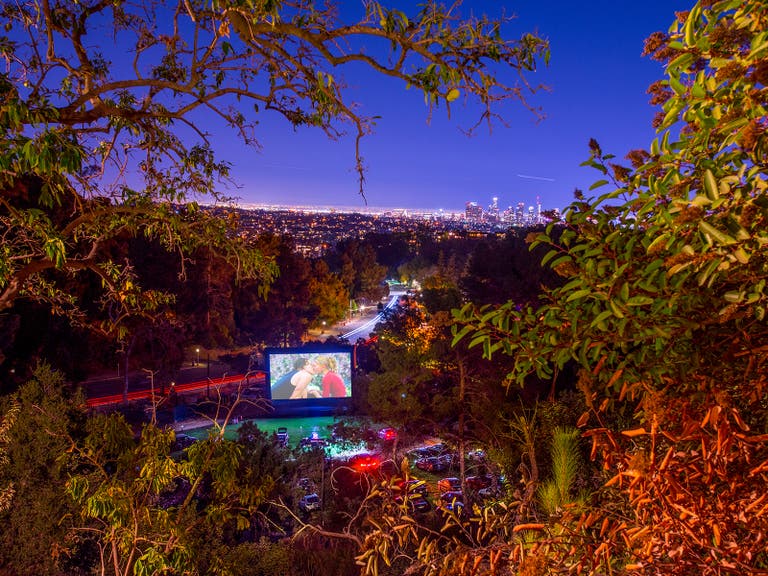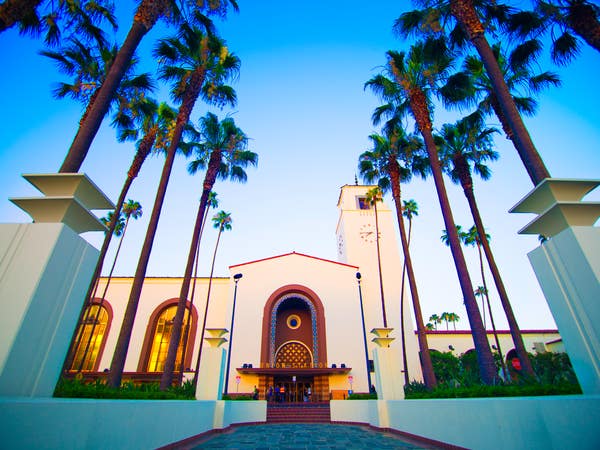Historic Academy Awards Venues
Some of LA's most famous and historic hotels and theatres have hosted the Oscars
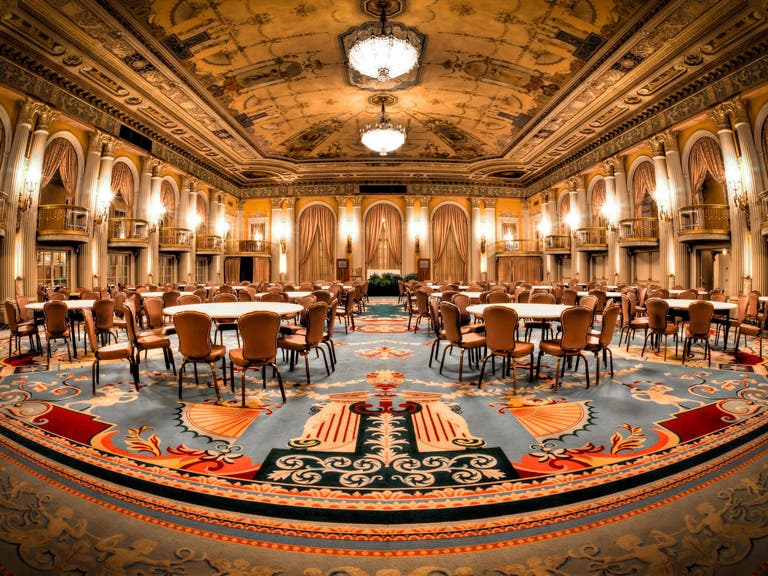
The 95th Academy Awards took place on Sunday, March 12 at the Dolby Theatre in Hollywood, the permanent home of the ceremony since 2002. Jimmy Kimmel hosted the Oscars for the third time.
Everything Everywhere All at Once led the field with 11 nominations and won seven: Best Picture, Best Director (The Daniels), Best Actress (Michelle Yeoh), Best Supporting Actor (Ke Huy Quan), Best Supporting Actress (Jamie Lee Curtis), Best Original Screenplay (The Daniels) and Best Editing (Paul Rogers). Yeoh made Oscars history as the first Asian woman to win Best Actress
The first Academy Awards ceremony was held at The Hollywood Roosevelt in 1929, and since then the Oscars have taken place at some of LA’s most famous and historic hotels and theatres.
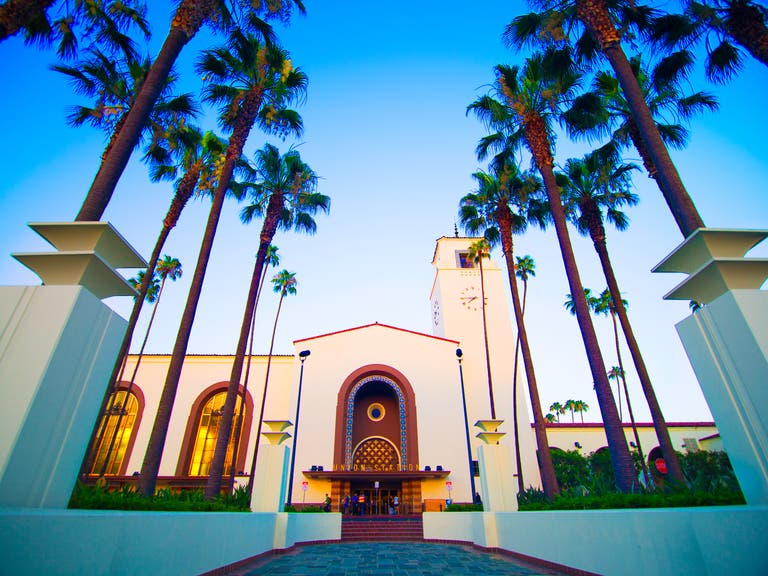
Union Station (2021)
In 2021, the 93rd Academy Awards took place for the first time at Union Station in Downtown LA. Nomadland took home three Oscars, including Best Picture, Best Actress (Frances McDormand) and Best Director for Chloé Zhao, who made history as the first woman of color to win; the first Asian woman nominated for Best Director; and is the most nominated woman in a single year in Oscar history. At age 83, Best Actor winner Anthony Hopkins (The Father) was the oldest performer to ever win a competitive acting Oscar.
Known as “the last of the great train stations,” Union Station is the largest railroad passenger terminal in the Western United States. The historic station was designed in a unique blend of Spanish Colonial, Mission Revival and Art Deco styles by the renowned father-son architect team of John and Donald Parkinson.
Opened in May 1939, Union Station is a major transportation hub for Southern California, serving 110,000 daily commuters with Amtrak long distance trains, Amtrak California regional trains, Metrolink commuter trains, and several Metro Rail subway and light rail lines. Union Station was added to the National Register of Historic Places in November 1980.
A star in its own right, Union Station has appeared in films for decades, including Blade Runner, The Dark Knight Rises, Pearl Harbor, and numerous Film Noirs.
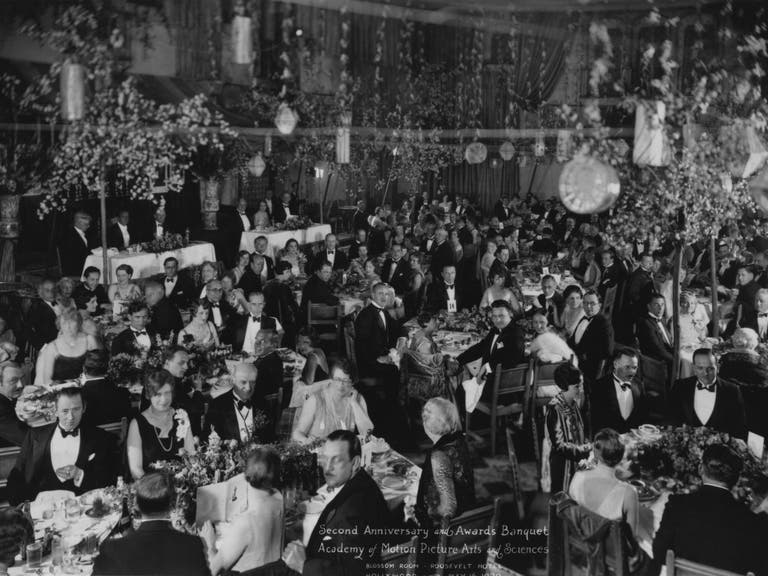
Hollywood Roosevelt Hotel (1929)
The first Academy Awards honored the best films of 1927 and 1928 and were presented at a private dinner on May 16, 1929 at the Hollywood Roosevelt Hotel. Named for President Theodore Roosevelt, the hotel opened in 1927 and was financed by a group that included Douglas Fairbanks, Mary Pickford and Sid Grauman. The ceremony was held in the hotel’s Blossom Ballroom, where 270 guests each paid $5 per ticket to attend the dinner and watch the presentation. Winners were announced three months before the ceremony, which was not broadcast on radio or television. The event was hosted by Academy president Douglas Fairbanks, who presented all of the golden statuettes in 15 minutes.

Biltmore Hotel & Ambassador Hotel (1930–1943)
Between 1930 and 1943, the Academy Awards alternated between the historic Millennium Biltmore Hotel in Downtown LA, and the now-demolished Ambassador Hotel, where the second Oscar ceremony took place inside the famed Cocoanut Grove nightclub.
At the time of its grand opening in 1923, the Biltmore was the largest hotel west of Chicago. During the Academy's early years, the Biltmore Bowl at the Millennium Biltmore was the site of eight Oscar ceremonies: 1931, 1935–39, and 1941-42. Today the Biltmore Bowl blends period details and the hotel's interior design with state-of-the-art audiovisual equipment, a pre-function foyer, a curtained stage and a long balcony that’s perfect for lavish buffets.
The Academy was founded in 1927 at a luncheon banquet in the Biltmore’s Crystal Ballroom, where guests such as Louis B. Mayer discussed plans for the new organization, as well as a special event to present film-industry achievement awards, an event that became the Oscars. According to legend, MGM art director Cedric Gibbons, who was also at the luncheon, sketched the design for the Oscar statue on a linen Biltmore napkin. The Crystal Ballroom features a hand-painted 30-foot ceiling, carved columns and Austrian-crystal chandeliers. The second-story balconies that surround the ballroom offer a wonderful vantage point to take in everything that’s happening below.
Movie fans will recognize the Biltmore from its numerous appearances in films like Ocean's 11 (1960), The Sting (1973), Chinatown (1974), Ghostbusters (1984), Beverly Hills Cop (1984) and Bugsy (1991).
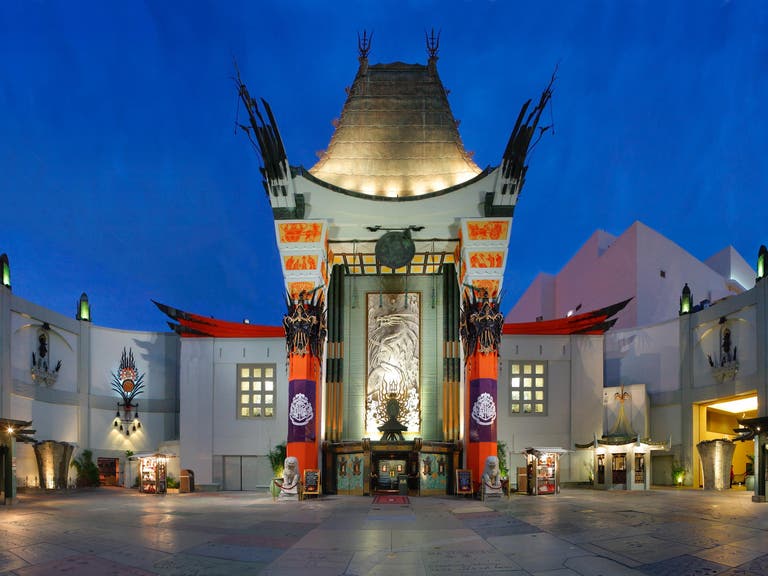
TCL Chinese Theatre (1944–1946)
The 16th Academy Awards took place in 1944 at Grauman's Chinese Theatre (now known as TCL Chinese Theatre) in Hollywood, the first time the ceremony was held in a large public venue. Grauman's opened in 1927 with a memorable Chinese design and the famous Forecourt to the Stars, which now has nearly 200 celebrity handprints, footprints and autographs immortalized in the concrete. Free passes to the 1944 ceremony were given out to men and women in uniform. For the first time, winners in the Best Supporting Actor and Actress categories were presented with full-size statuettes, instead of smaller-sized awards mounted on a plaque. Casablanca won Best Picture that year, which would be the last time until 2009 that there were 10 nominees in the Best Picture category. Grauman's Chinese Theatre also hosted the Oscars in 1945 and 1946.
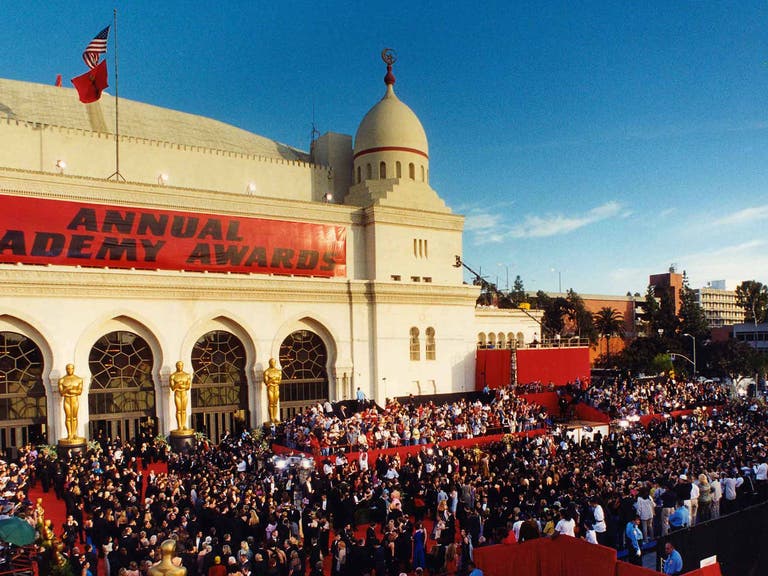
Shrine Auditorium (1947–1948)
The Oscars moved back to Downtown L.A. for the 19th Academy Awards, which took place in 1947 at the Shrine Auditorium. The Shrine would also host the 20th Oscars ceremony in 1948, and eventually hosted a total of ten Academy Awards.
At the time of its opening in 1926, the Shrine featured a unique Moorish Revival design, the largest proscenium stage in North America, a 3,000-seat freestanding balcony and an adjoining expo hall. Movie fans will recognize the Shrine stage from the 1933 film King Kong, in the classic scene where the captive ape is revealed to the public.
Academy Award Theatre (1949)
In 1949, the Oscars were held for the only time at the Academy Award Theatre. According to the Academy’s website, the ceremony was moved from the Shrine Auditorium to the Academy’s own theater “primarily because the major Hollywood studios had withdrawn their financial support in order to address rumors that they had been trying to influence voters.”
The 21st Academy Awards featured a number of firsts. Hamlet became the first non-Hollywood production to win Best Picture, and Hamlet director and star Laurence Olivier became the first person to direct himself in an Oscar-winning performance. John Huston (Best Director, The Treasure of the Sierra Madre) directed two Oscar-winning performances in the same year for two different films: his father Walter Huston in The Treasure of the Sierra Madre, and Claire Trevor for Key Largo. Jane Wyman became the first actor since the silent era to win an Oscar for a performance with no lines. It was also the debut of the award for Best Costume Design.
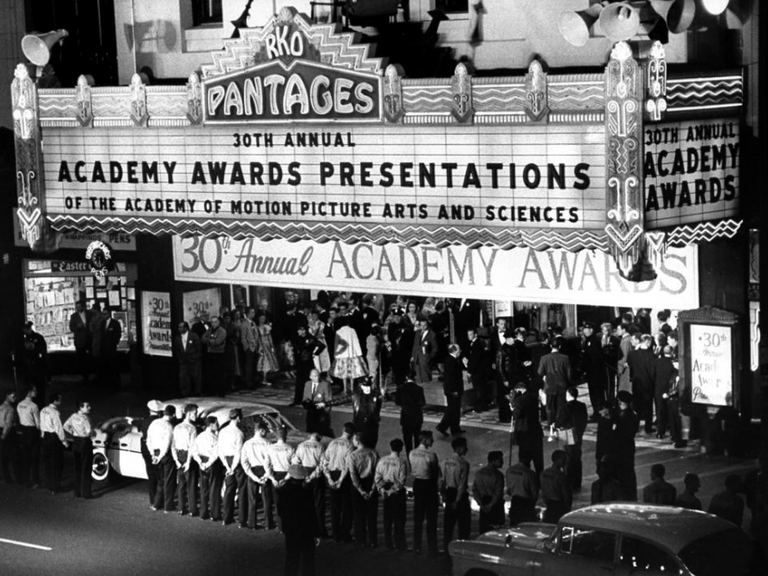
Pantages Theatre (1950-1960)
In 1950, the Academy Awards were held for the first time at the Pantages Theatre in Hollywood. Located at the iconic intersection of Hollywood and Vine, the Pantages Theatre was designed by architect B. Marcus Priteca and was the last theater built by vaudeville impresario Alexander Pantages. The landmark Art Deco theater opened in 1930 as part of the Pantages Theatre Circuit.
The 25th Academy Awards ceremony was held in 1953 at the Pantages Theatre in Hollywood and the now-demolished NBC International Theatre in New York City. It was the first time the Academy Awards were televised, and it was the first Oscars ceremony that took place in Hollywood and New York City simultaneously. In one of the all-time upsets, the heavily favored High Noon lost the Best Picture award to Cecil B. DeMille's The Greatest Show on Earth. With five awards that night, The Bad and the Beautiful earned the most wins ever for a film not nominated for Best Picture.
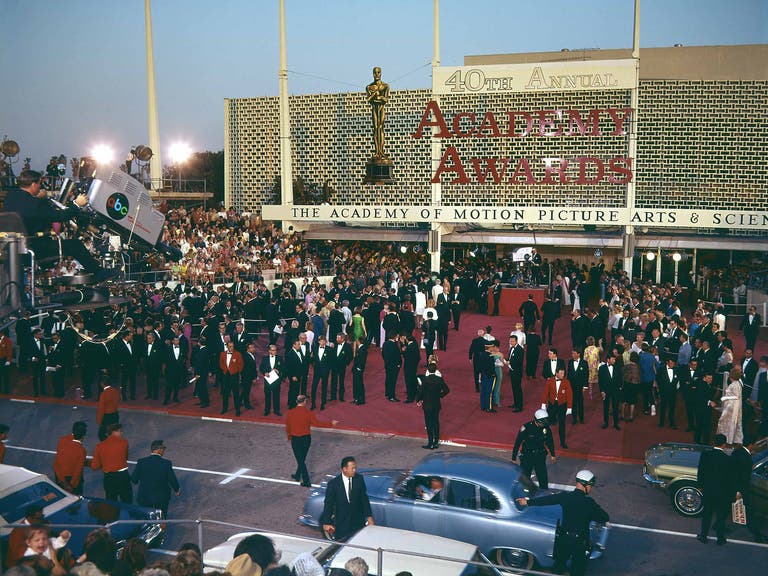
Santa Monica Civic Auditorium (1961–1968)
For the 33rd Academy Awards in 1961, the ceremony moved west to the Santa Monica Civic Auditorium. Built in 1958, the Santa Monica Civic Auditorium was designed by renowned architect Welton Becket, whose other landmarks include the Music Center, the Capitol Records Building and the Cinerama Dome. The Apartment was named Best Picture at the 1961 Oscars, the last black and white film to win in that category until 1993, when Schindler's List won.
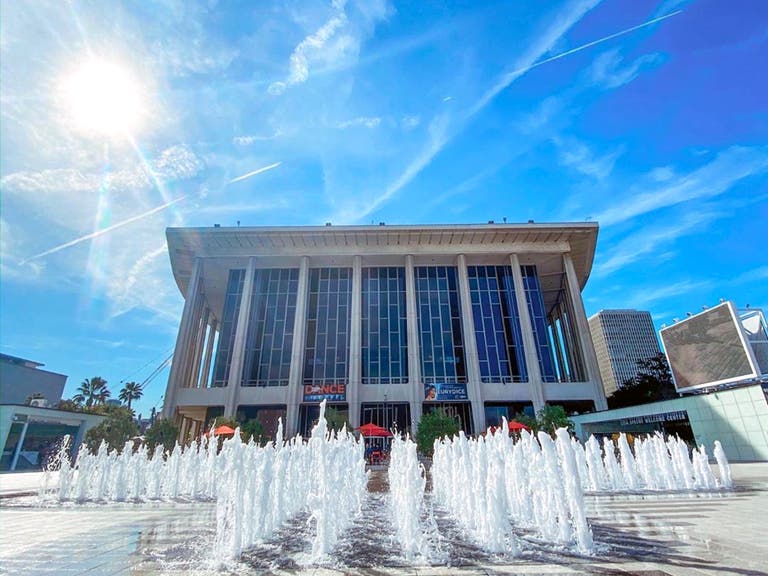
Dorothy Chandler Pavilion (1969–1987)
In 1969, the Oscars returned to Downtown LA for the 41st Academy Awards, which were held at the Dorothy Chandler Pavilion. Opened in 1964, the Pavilion boasts one of the largest stages in the country and is home to the LA Opera and Glorya Kaufman Presents Dance at the Music Center. The 41st Academy Awards were the first Oscar ceremony to be broadcast worldwide. Oliver! became the first and only G-rated film to win Best Picture, and Stanley Kubrick would win his only Oscar, Best Visual Effects for 2001: A Space Odyssey. That year was the only time there was a tie in the Best Actress category: Katharine Hepburn for The Lion in Winter, and Barbra Streisand for Funny Girl.
Dorothy Chandler Pavilion & Shrine Auditorium (1988–2001)
From 1988 to 2001, the Academy Awards alternated between the Dorothy Chandler Pavilion and the Shrine Auditorium, which hosted the ceremony eight times between 1988 and 2001. The 70th Academy Awards took place at the Shrine Auditorium in 1998, the year that Titanic won 11 Oscars, including Best Picture and James Cameron for Best Director. The popularity of Titanic, which was the No. 1 movie in the country when the ceremony took place, helped the 70th Academy Awards become the highest-rated broadcast in Oscars history.
